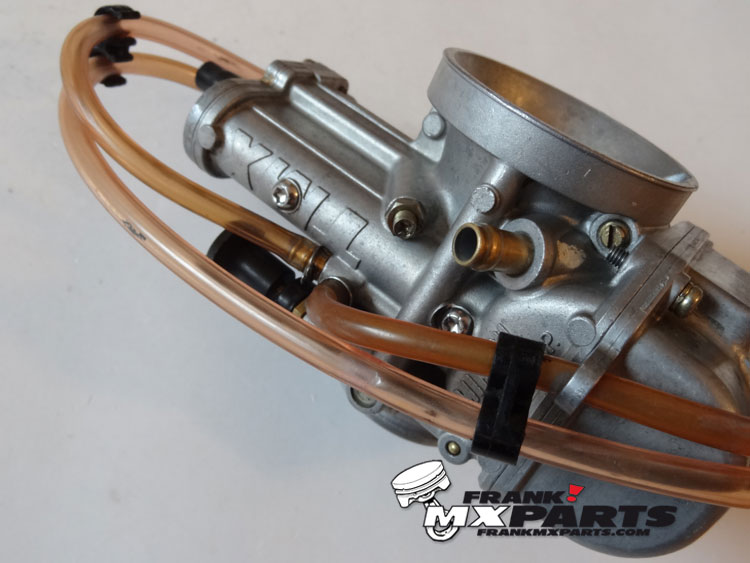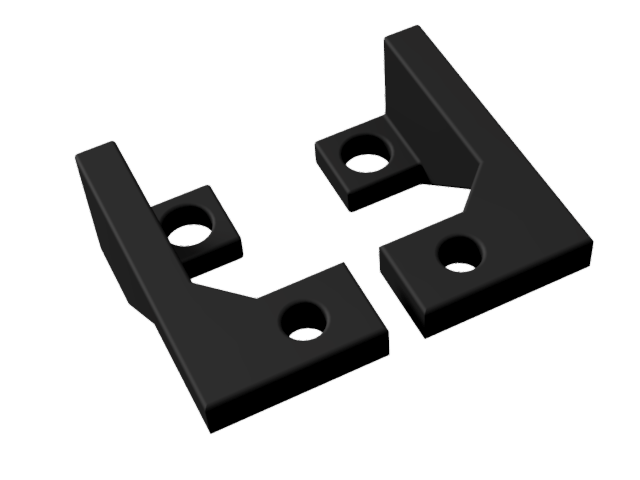While jetting carburetors, place a piece of tape on the throttle housing. Place another piece of tape on the throttle grip and draw a line (while the throttle is at idle) straight across from one piece of tape to the other. When these two lines are lined up, the engine will be idling. Now open the throttle to full throttle and draw another line directly across from it on the throttle housing. At this point, there should be two lines on the throttle housing, and one on the throttle grip. Now find the half-way point between both of the lines on the throttle housing. Make a mark and this will show when the throttle is at half throttle. Divide the spaces up even again until idle, 1/4, 1/2, 3/4, and full throttle positions are known. These lines will be used to quickly find the exact throttle opening while jetting.
Clean the air filter and warm the bike up. Accelerate through the gears until the throttle is at full throttle (a slight uphill is the best place for this). After a few seconds of full throttle running, quickly pull in the clutch and stop the engine (Do not allow the engine to idle or coast to a stop). Remove the spark plug and look at its color. It should be a light tan color (for more info on reading spark plugs click here). If it's white, the air/fuel mixture is too lean and a bigger main jet will have to be installed. If it's black or dark brown, the air/fuel mixture is too rich and a smaller main jet will have to be installed. While changing jets, change them one size at a time, test run after each change, and look at the plug color after each run.
After the main jet has been set, run the bike at half throttle and check the plug color. If it's white, lower the clip on the jet needle to richen the air/fuel mixture. If it's dark brown or black, raise the clip to lean the air/fuel mixture.
The pilot circuit can be adjusted while the bike is idling and then test run. If the engine is running poorly just off of idle, the pilot jet screw can be turned in or out to change the air-fuel mixture. If the screw is in the back of the carburetor, screwing it out will lean the mixture while screwing it in will richen it. If the adjustment screw is in the front of the carburetor, it will be the opposite. If turning the screw between one and two and a half doesn't have any affect, the pilot jet will have to be replaced with either a larger or smaller one. While adjusting the pilot screw, turn it 1/4 turn at a time and test run the bike between adjustments. Adjust the pilot circuit until the motorcycle runs cleanly off of idle with no hesitations or bogs.
Altitude, Humidy, and Air Temperature
Met Cosi Fan Tutte Live 2018 full movie torrent download; Met Cosi Fan Tutte Live 2018 tebbyko PDVD download movie torrent; Get uTorrent: Posted on January 1. Torrentz - Fast and convenient Torrents Search Engine. Cosi Fan Tutte.(All Ladies Do It).Tinto.Brass. Hash 12F13D381BE7B2C150473CF5360D25, Download for. Jun 03, 2019 Download torrent. Information about the torrent Cosi Fan Tutte - Tinto Brass.avi. Seeders, leechers and torrent status is updated several times per day. Cosi Fan Tutte - Tinto Brass.avi 12 torrent download locations thepiratebay.se Tinto Brass - Cosi fan tutte DVDrip - XviD - Ita Video Movies 3 days. Cos d0 93%c2 ac fan tutte tinto brass torrent
download 2017. Tinto Brass Corti Circuiti Erotici Vol.2 (1999) Tinto Brass Presents Erotic Short Stories Vol.2/Tinto Brass Corti Circuiti Erotici Vol.2 (1999).srt 32.30KB; Tinto Brass Corti Circuiti Erotici Vol.3 (1999) Tinto Brass Presents Erotic Short Stories Vol.3/Tinto Brass Corti Circuiti Erotici Vol.3 (1999).avi 699.16MB.
Once the jetting is set and the bike is running good, there are many factors that will change the performane of the engine. Altitude, air temperature, and humidity are big factors that will affect how an engine will run. Air density increases as air gets colder. This means that there are more oxygen molecules in the same space when the air is cold. When the temperature drops, the engine will run leaner and more fuel will have to be added to compensate. When the air temperature gets warmer, the engine will run richer and less fuel will be needed. An engine that is jetted at 32deg Fahrenheit may run poorly when the temperature reaches 90deg Fahrenheit.
Altitude affects jetting since there are less air molecules as altitude increases. A bike that runs good at sea level will run rich at 10,000 ft due to the thinner air.
Humidity is how much moister is in the air. As humidity increases, jetting will be richer. A bike that runs fins in the mornings dry air may run rich as the day goes on and the humidity increases.
Mikuni Tmx38
Correction factors are sometimes used to find the correct carburetor settings for changing temperatures and altitudes. The chart in fig 8, shows a typical correction factor chart. To use this chart, jet the carburetor and write down the pilot and main jet sizes. Determine the correct air temperature and follow the chart over to the right until the correct elevation is found. Move straight down from this point until the correct correction factor is found. Using fig 8 as an example, the air temperature is 95deg Fahrenheit and the altitude is 3200 ft. The correction factor will be 0.92. To find out the correction main and pilot jets, multiple the correction factor and each jet size. A main jet size of 350 would be multiplied by 0.92 and the new main jet size would be a 322. A pilot jet size of 40 would be multiplied by 0.92 and the pilot jet size would be 36.8.
FIG 8
Correction factors can also be used to find the correct settings for the needle jet, jet needle, and air screw. Use the chart from fig 9 and determine the correction factor. Then use the table below to determine what to do with the needle jet, jet needle, and air screw.
Needle Jet/Jet Needle/Air Screw Correction Chart |
Correction factor | 1.04 or above | 1.04-1.00 | 1.00-0.96 | 0.96-0.92 | 0.92 or below |
Needle jet | Two sizes larger | One size larger | Same size | One size smaller | Two sizes smaller |
Jet needle setting | Lower clip position | Same | Same | Same | Raise clip one position |
Air screw opening | One turn in | 1/2 turn in | Same | 1/2 turn out | One turn out |
FIG 9
This article was written by, and has been reprinted with the permission of Doug Jenks. All rights reserved.
[email protected]
Back to page.


